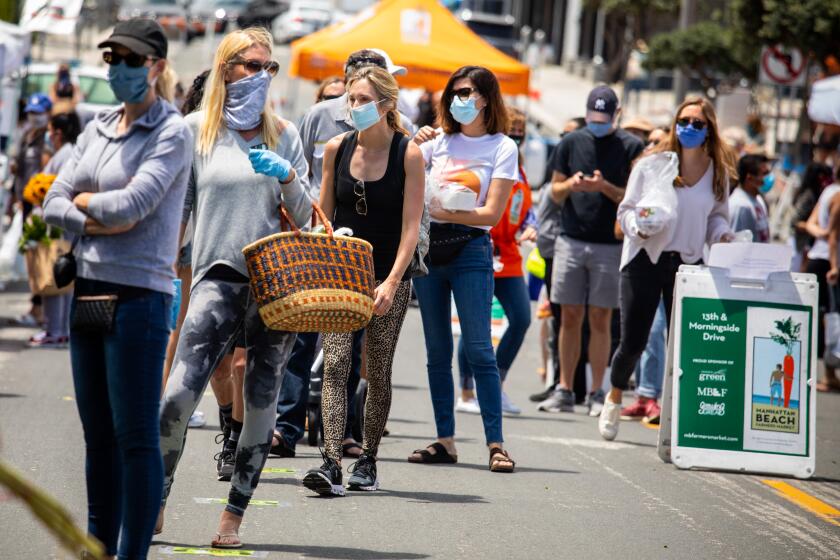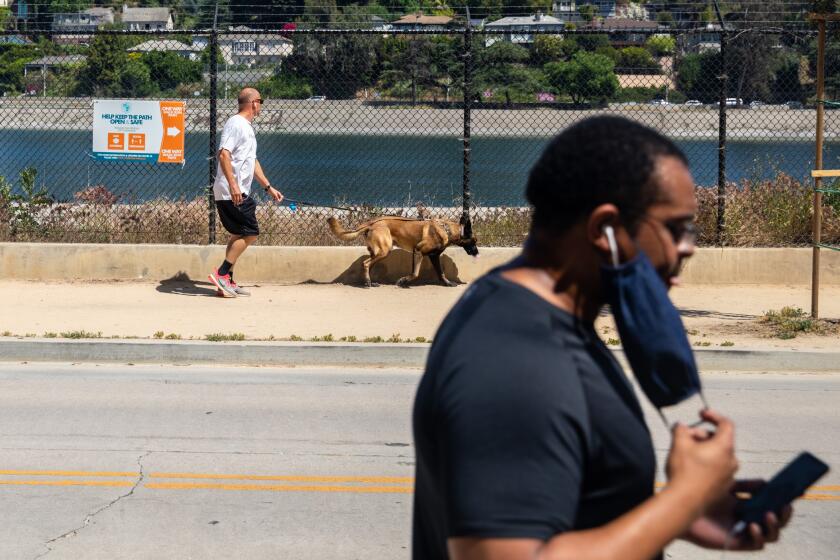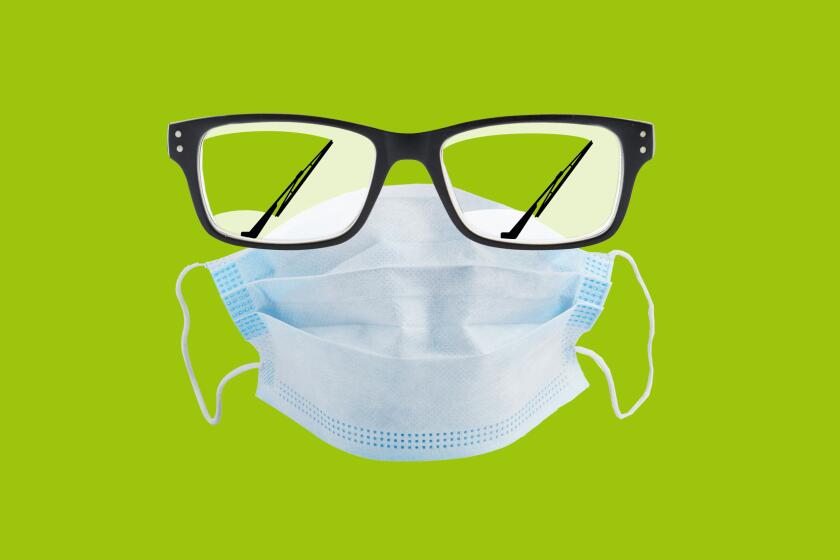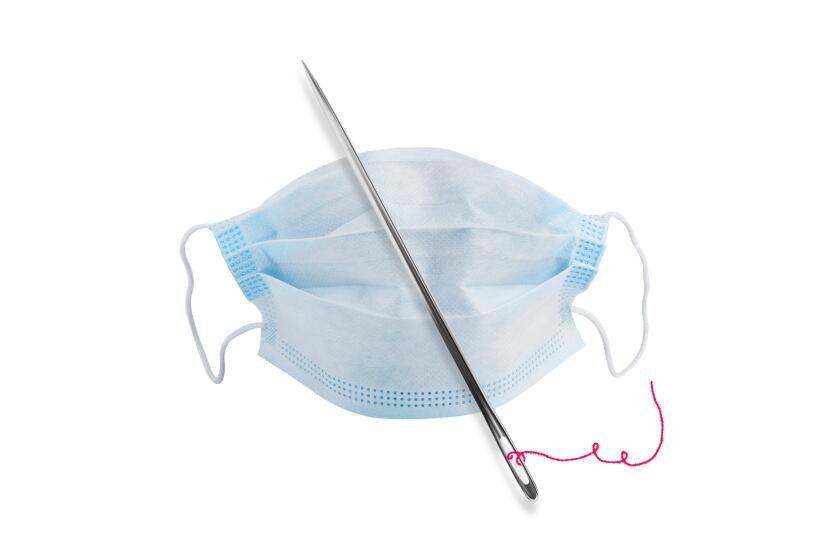Face masks are now a mandatory L.A. accessory. Can we keep covered up?
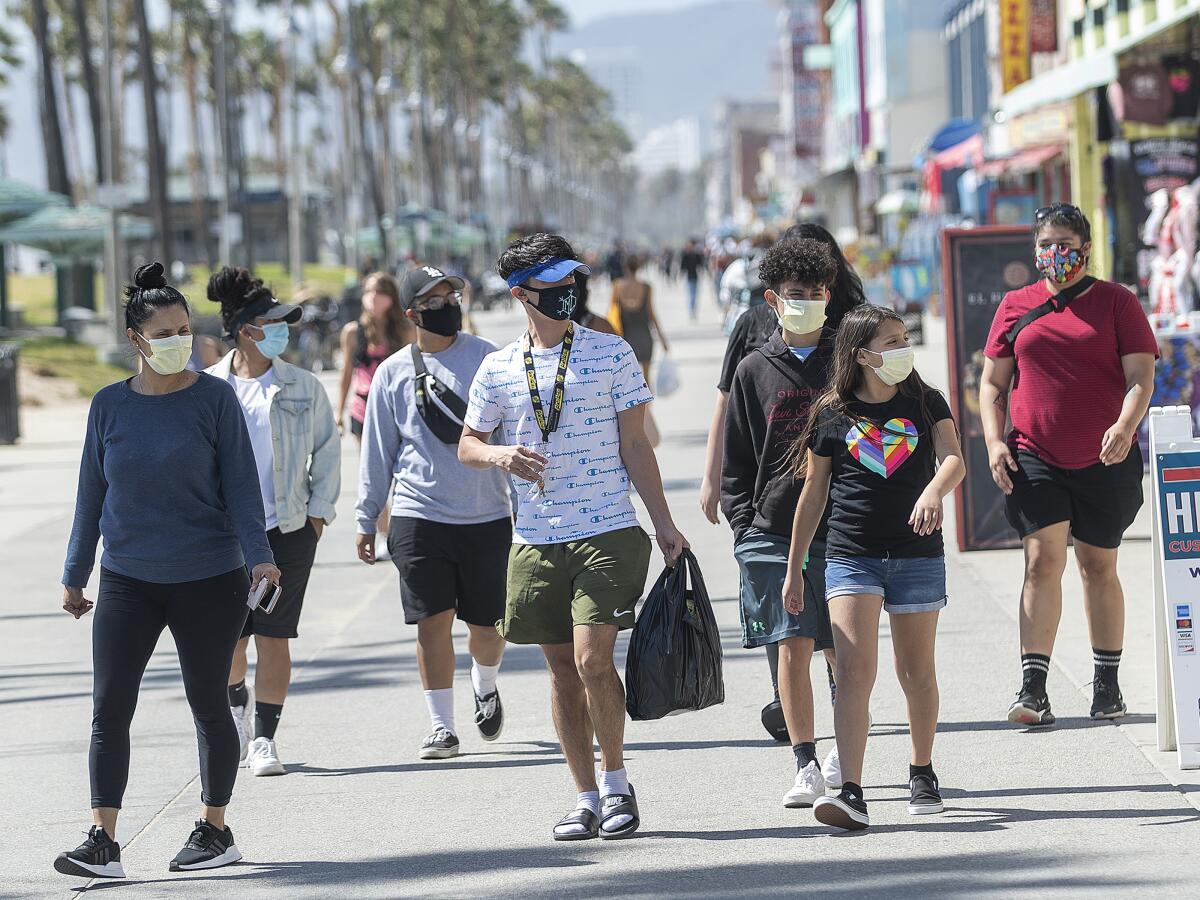
- Share via
After weeks of telling residents to stay indoors, L.A. officials this week started easing strict stay-at-home rules.
But Angelenos desperate to return to the beaches, mountains and trails as summer approaches, just learned there is a catch. Both city and county officials said residents must wear face coverings when going outdoors.
The rules apply “any time you’re out and there are people around, whether it be at a trail head or a parking lot or a sidewalk,” Barbara Ferrer, Los Angeles County’s director of public health, said Thursday.
In the city of L.A., the new law requires face coverings for walking, running, cycling, scooting, roller skating, skateboarding and all outdoor activities except for those on the water, according to the order from Mayor Eric Garcetti. Elsewhere in L.A. County, you can still be outdoors without a face covering when there is no one else around, but must put it on when others approach, Ferrer said.
For joggers, runners and others eager to get back to their exercise routine, the rules came with acceptance and concerns as well as questions.
“I can’t breathe with the mask when I’m working out,” said Rabi Awssd, 35, while taking a break from his five-mile run down Beachwood Drive. “I can’t use it.”

The move makes Los Angeles the strictest of the state’s largest cities when it comes to face coverings. Residents of San Diego, San Francisco and San Jose can go without them so long as they practice social distancing. In San Diego, that means staying six feet away from other joggers or strollers.
Masks are required outdoors in Los Angeles city and county, but the rules are different in Orange County, Riverside County and elsewhere.
Public Health officials and experts said the policy is designed to slow the spread of the coronavirus and, it’s hoped, speed up the reopening of the economy. Los Angeles County remains the epicenter of the outbreak in California, with more than 1,700 deaths and 35,000 confirmed cases.
Cloth face coverings, experts say, are a key component in combating COVID-19 because they can help block transmission of respiratory droplets that carry the disease.
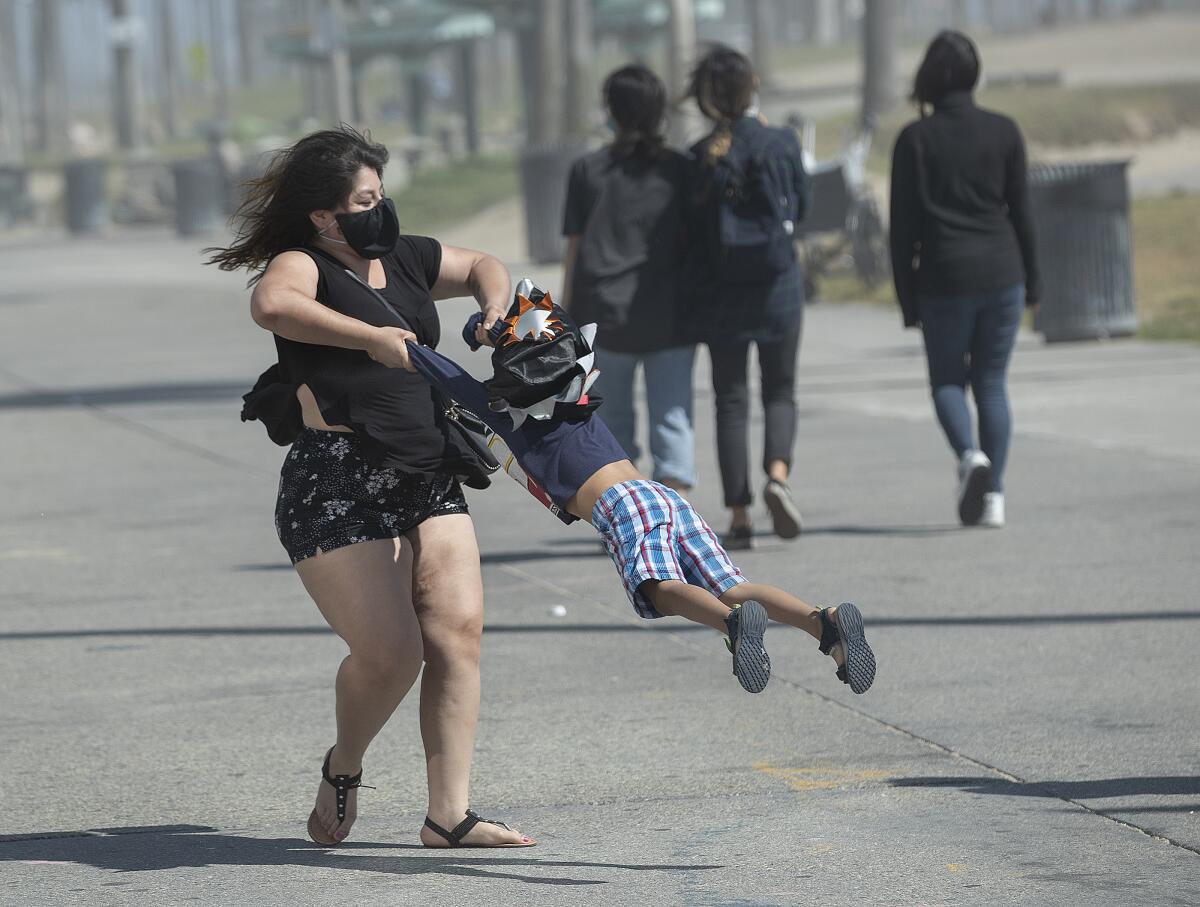
That’s just smart policy, say many residents, including those who proudly wear masks soaked in sweat. Down the hill from the Hollywood sign, friends Karina Delgado, 43, and Jessica Gonzalez, 46, jogged fully masked and fully protected on neighboring streets.
“I support what the mayor is doing,” Gonzalez said. “This is all about safety and making sure we avoid infections. Just because we’re not seeing the number of infections like in New York, people think we’re going to go back to some sort of normal.”
The orders by L.A. city and county have joggers, runners and others seeking exercise trying to figure out how to incorporate masks into their workouts.
As the pair stopped to stretch, two unmasked cyclists passed within 10 feet of them.
There were no cops in sight. In San Diego, the cyclists might have received advice instead of a summons. Workers for the local transit district have been handing out masks in recent days to riders who flout the rules.
In Los Angeles, days into the new world of face masks for all, the level of enforcement is an open question. Even some police officers don’t seem to be following the rules that already existed for patrons of indoor establishments.
Two officers caused a stir on Wednesday when a diner at a fast-food restaurant videotaped them without masks on. They were asked by an employee at the Chipotle in Baldwin Hills why they weren’t wearing coverings.
“No, ma’am, we come in contact with nasty stuff every day,” one of the cops said, according to the video shared with The Times.

Two officers caused a stir recently when a diner at a fast-food restaurant recorded them not wearing masks.
The new restrictions require face coverings whenever people leave the house. This applies to everyone except small children and those with certain disabilities. In some communities, the strict approach won’t change routines already shaped by the pandemic threat.
In Koreatown, most everyone was already wearing a mask, said Bethany Leal, the deputy director of Koreatown Immigrant Workers Alliance. Even though face coverings have been long been mandated, a few customers in markets went without masks, she said. “The cashiers feel the most vulnerable.”
But the new rule may have helped compliance across the board, Leal said. Workers in Koreatown were reporting Thursday that there was nary a bare face in sight.
That’s becoming commonplace around the world. More than 70 countries now require face coverings in public, according to Masks4All, a group of scientists and researchers that sees the practice as essential to reducing the spread of the virus.
Wearing masks will help minimize the spread of COVID-19. Here’s how to do it right.
In the U.S., much confusion remains about the purpose of a face covering. Medical-grade respirators like N95 masks provide protection for the wearer, but experts say a cloth face covering is about protecting others.
Up to 50% of those infected with COVID-19 may be asymptomatic yet still infectious. Because anyone can be infected without knowing it, many experts say universal face coverings are the only way out of the pandemic.
“Every country that has been using masks since early in the pandemic is getting much much better results,” said Jeremy Howard, a Masks4All organizer. In the U.S., most states still don’t require masks, which puts them at risk, said Howard, a distinguished research scientist at the University of San Francisco. “States are coming out of lockdown without mask requirements, which just seems like a recipe for the second wave.”
California’s actions against the novel coronavirus have been relatively swift, as the state’s largest cities and counties have imposed varying levels of restrictions.
In San Diego, masks are required in public but only when the wearer is within six feet of others. Jogging, bicycling and other outdoor activities are exempt, though the city does require residents to carry a mask outdoors and have it readily available in case other people appear.
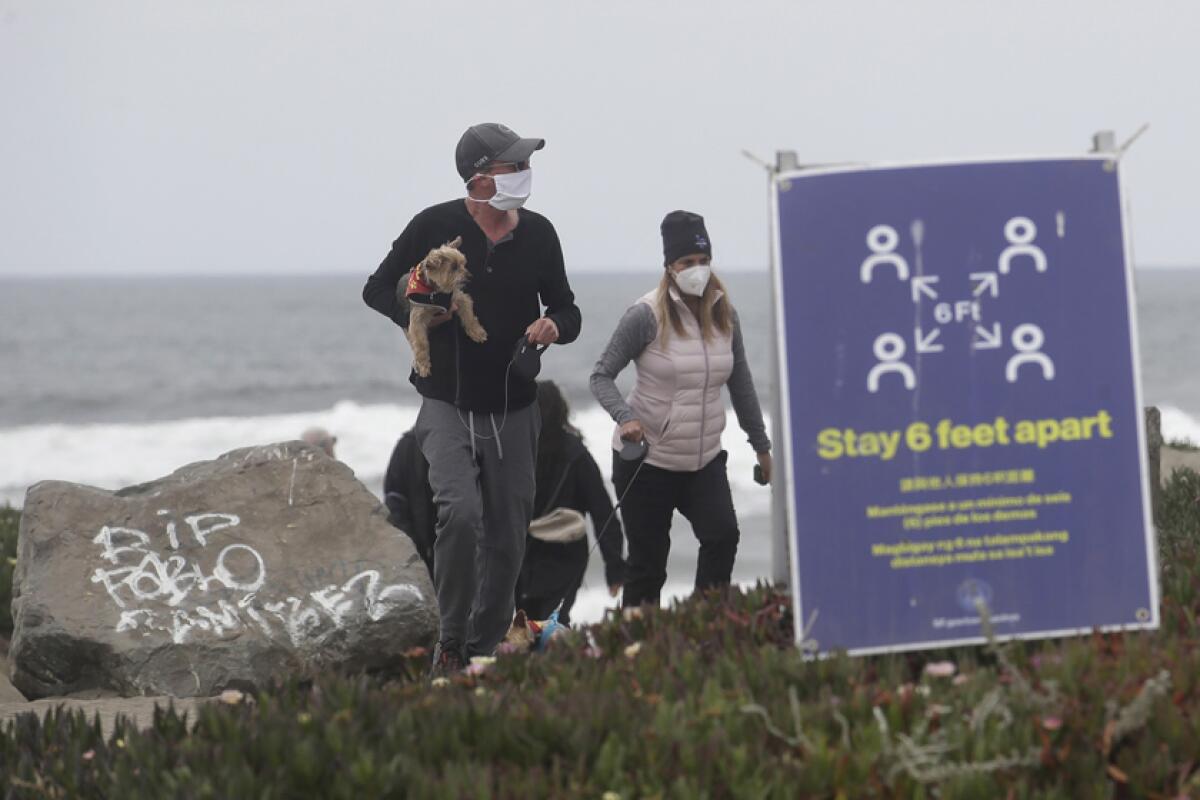
In San Francisco, face coverings are required in public indoor facilities and outdoors when waiting in line for public transportation or entering a store. But outdoor exercise such as walking, jogging and cycling can be done with fresh air on uncovered faces.
In Los Angeles, a face covering can be anything from a bandanna to a homemade cloth mask. With medical-grade respirators and surgical masks in short supply, authorities urge residents to use whatever they have on hand, even if it’s just a T-shirt.
At the Silver Lake Reservoir on Thursday afternoon, compliance with the new rule was decidedly mixed. While the majority of walkers, joggers and cyclists wore facial coverings — masks, bandannas and various cloth items — dozens also exercised without protective equipment.
Laura Burhenn, 40, had jogged about a block from her home to the Silver Lake Recreation Center with her rescue dog when she realized she didn’t have a mask and technically was flouting the new rules. She recognized the need for increased safety measures, but thought the new rule was an “overreach.”
DIY coronavirus mask instructions from crafters and doctors.
“If you’re distancing and out in the open, that’s pretty safe... It’s one thing when you’re indoors, but I don’t see the need when you’re outside by yourself,” she said.
Fellow Silver Lake resident Allison Lei, 34, also did not wear a mask while reading on a soft throw blanket in a shady grasspatch near the recreation center. Though she had a mask in her purse, Lei didn’t feel the need to cover her face since the next closest person was about 20 feet away.
“It’s my understanding the reason you wear a mask is to prevent spreading COVID-19 to other people,” Lei said. “But, if no one is around, then why should I wear a mask?”
Many residents seemed to follow the same approach, softening the strict mandate with the need for more practical considerations.
Javi Chad-Friedman, a 26-year-old Beachwood Canyon resident, was jogging bare-faced when he a saw other runners nearby. He immediately stopped, reached into his back pocket and pulled out his black-and-yellow mask, which included the insignia of a friend’s band.
“I wear a mask, I do,” he said “It’s just when you run or do physical exercise, it’s difficult, but as soon as I see anyone nearby, I put on my mask.”
More to Read
Sign up for Essential California
The most important California stories and recommendations in your inbox every morning.
You may occasionally receive promotional content from the Los Angeles Times.
